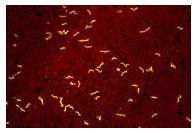Relapsing fever laboratory findings: Difference between revisions
| Line 4: | Line 4: | ||
==Overview== | ==Overview== | ||
*The presence of [[spirochetes]] in [[Peripheral blood smear|smears of peripheral blood]], [[bone marrow]], or [[cerebrospinal fluid]] in a [[symptomatic]] person is [[diagnostic]] of [[relapsing fever]]. | *The presence of [[spirochetes]] in [[Peripheral blood smear|smears of peripheral blood]], [[bone marrow]], or [[cerebrospinal fluid]] in a [[symptomatic]] person is [[diagnostic]] of [[relapsing fever]]. | ||
The [[diagnosis]] of [[relapsing fever]] is confirmed by the identification of the borrelia in the patient's [[blood]] under [[microscopy]]. Laboratory tests may also reveal [[anemia]] with increased [[leukocyte]] count. Biochemistry may reveal [[hypoglycemia]], elevated [[LDH]], [[acidosis]], and mild [[hyponatremia]] due to [[vomiting]] and [[diarrhea]]. In severe disease, elevated [[creatinine]], [[proteinuria]], and [[hemoglobinuria]] may be present secondary to [[renal failure]].<ref name=CDC>{{cite web | title = Malaria | url = http://www.cdc.gov/malaria/about/disease.html }}</ref><ref>{{cite book | last = Mandell | first = Gerald | title = Mandell, Douglas, and Bennett's principles and practice of infectious diseases | publisher = Churchill Livingstone/Elsevier | location = Philadelphia, PA | year = 2010 | isbn = 0443068399 }}</ref> Other malaria-specific tests include: the [[antigen detection test]], [[PCR]], and [[serology]] test for the presence of [[antibodies]] against the [[plasmodium]]. [[Drug resistance]] tests should also be performed to assess the susceptibility of the [[microorganism]] to the [[antimalarial drug]]s. | |||
==Laboratory Findings== | ==Laboratory Findings== | ||
Revision as of 01:17, 25 September 2020
|
Relapsing fever Microchapters |
|
Diagnosis |
|---|
|
Treatment |
|
Case Studies |
|
Relapsing fever laboratory findings On the Web |
|
American Roentgen Ray Society Images of Relapsing fever laboratory findings |
|
Risk calculators and risk factors for Relapsing fever laboratory findings |
Editor-In-Chief: C. Michael Gibson, M.S., M.D. [1]
Overview
- The presence of spirochetes in smears of peripheral blood, bone marrow, or cerebrospinal fluid in a symptomatic person is diagnostic of relapsing fever.
The diagnosis of relapsing fever is confirmed by the identification of the borrelia in the patient's blood under microscopy. Laboratory tests may also reveal anemia with increased leukocyte count. Biochemistry may reveal hypoglycemia, elevated LDH, acidosis, and mild hyponatremia due to vomiting and diarrhea. In severe disease, elevated creatinine, proteinuria, and hemoglobinuria may be present secondary to renal failure.[1][2] Other malaria-specific tests include: the antigen detection test, PCR, and serology test for the presence of antibodies against the plasmodium. Drug resistance tests should also be performed to assess the susceptibility of the microorganism to the antimalarial drugs.
Laboratory Findings


Microscopic Diagnosis
- The presence of spirochetes in smears of peripheral blood, bone marrow, or cerebrospinal fluid which stained with Giemsa, May-Grünwald Giemsa, Wright, Wright-Giemsa, Field's, or Diff-Quick stains, or examined under dark-field while the patient is febrile, is diagnostic of relapsing fever. Although best visualized by darkfield microscopy, the organisms can also be detected by Wright-Giemsa or acridine orange-stained preparations.
- With subsequent febrile episodes, the number of circulating spirochetes decreases, making it harder to detect spirochetes on a peripheral blood smear. Even during the initial episode spirochetes will only be seen 70% of the time. [3]
Molecular Diagnosis and serology
- Antibody tests and PCR is available through public health laboratories and some private laboratories. Although there are false-positive and false-negative results.
Other laboratory findings
More common:
- Normal to increased white blood cell count with a left shift towards immature cells
- Mild to moderate thrombocytopenia
- Mild anemia
- Elevated ESR
Less common:
- Mildly increased serum bilirubin and hepatic aminotransferase level
- increased urea nitrogen, creatinine
- Slightly prolonged coagulation tests, PT and APTT, as well as proteinuria or hematuria, are also common
References
- ↑ "Malaria".
- ↑ Mandell, Gerald (2010). Mandell, Douglas, and Bennett's principles and practice of infectious diseases. Philadelphia, PA: Churchill Livingstone/Elsevier. ISBN 0443068399.
- ↑ Fotso Fotso A, Drancourt M (2015). "Laboratory Diagnosis of Tick-Borne African Relapsing Fevers: Latest Developments". Front Public Health. 3: 254. doi:10.3389/fpubh.2015.00254. PMC 4641162. PMID 26618151.